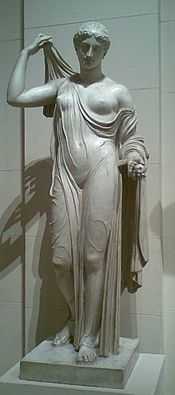Callimachus (sculptor)

Callimachus (Greek: Καλλίμαχος Kallímachos) was an architect and sculptor working in the second half of the 5th century BC in the manner established by Polyclitus. He was credited with work in both Athens and Corinth and was probably from one of the two cities. According to Vitruvius (iv.1), for his great ingenuity and taste the Athenians dubbed Callimachus katatêxitechnos (literally, 'finding fault with one's own craftsmanship': perfectionist). His reputation in the 2nd century AD was reported in an aside by Pausanias as one "although not of the first rank of artists, was yet of unparalleled cleverness, so that he was the first to drill holes through stones"—that is, in order to enhance surface effects of light and shade in locks of hair, foliage and other details. Thus it is reported that Callimachus was known for his penchant for elaborately detailed sculptures or drapery, though few securely attributed works by him survive.
Sculpture
_01.jpg)
_02.jpg)
_03.jpg)
_04.jpg)
Callimachus is credited with the sculptures of Nikes on the frieze of the Temple of Athena Nike ("Athena, Bringer of Victory") on the Propylaea of the Acropolis of Athens. The small temple was commissioned by Pericles shortly before his death in 429, and built ca 427– 410. Pliny mentions his Laconian Dancers. Six ecstatic Maenads attributed to him exist in Roman copies.
The clinging draperies of the above works has led to the original of the Venus Genetrix type (whose draperies are similarly clinging) being also attributed to him.
Architecture
Callimachus is credited with inventing the Corinthian capital, which Roman architects erected into one of the Classical orders. The attribution comes from Vitruvius's On Architecture (book IV) (here in Morris Hicky Morgan's translation):
- It is related that the original discovery of this form of capital was as follows. A freeborn maiden of Corinth, just of marriageable age, was attacked by an illness and died. After her burial, her nurse, collecting a few little things which used to give the girl pleasure while she was alive, put them in a basket, carried it to the tomb, and laid it on top thereof, covering it with a roof-tile so that the things might last longer in the open air. This basket happened to be placed just above the root of an acanthus. The acanthus root, pressed down meanwhile though it was by the weight, when springtime came round put forth leaves and stalks in the middle, and the stalks, growing up along the sides of the basket, and pressed out by the corners of the tile through the compulsion of its weight, were forced to bend into volutes at the outer edges.
- Just then Callimachus, whom the Athenians called katatêxitechnos for the refinement and delicacy of his artistic work, passed by this tomb and observed the basket with the tender young leaves growing round it. Delighted with the novel style and form, he built some columns after that pattern for the Corinthians, determined their symmetrical proportions, and established from that time forth the rules to be followed in finished works of the Corinthian order.
There is no way to corroborate Vitruvius's account, but since the elaborate design of the Corinthian column resembles other works attributed to Callimachus, the attribution seems reasonable to modern architectural historians. The complex and difficult design of the column's capital often required drilling to undercut the leaf edges.
In the cella of the Erechtheion hung an ingenious golden lamp invented by Callimachus, according to Pausanias' Description of Greece: it needed to be refilled with oil only once a year. Above it hung a bronze palm branch which trapped any rising smoke.
An inscription[1] from Aigai of the late 5th century BC may be attributed to some work of Callimachus and the time when Archelaus invited artists to Macedon.
Ancient sources
- Pausanias, (I.xxvi.6-7); Vitruvius (IV.1.9-10); Pliny the Elder, Natural History XXXIV.xix.32)
Notes
- ↑ Mary Stieber: Further Thoughts on 'Eustylos' in Euripides' Iphigenia Among the Taurians, Vitruvius, and a Late Fifth-Century B. C. Inscription from Vergina 1996 (SEG 46:830) - translation : here Kallim- ..of well-pillared temples (eustyloi naoi) .. of esteemed father...art..
External links
| Wikisource has the text of the 1911 Encyclopædia Britannica article Callimachus (sculptor). |
- Vitruvius Pollio, The Ten Books on Architecture, Book IV Chapter 1 from the Perseus Project.
- Alleskunst.Net: Kallimachos (in English)
- Smith-Platner
- Andrew Stewart One Hundred Greek Sculptors: Their Careers and Extant Works: Kallimachos (On-line text)